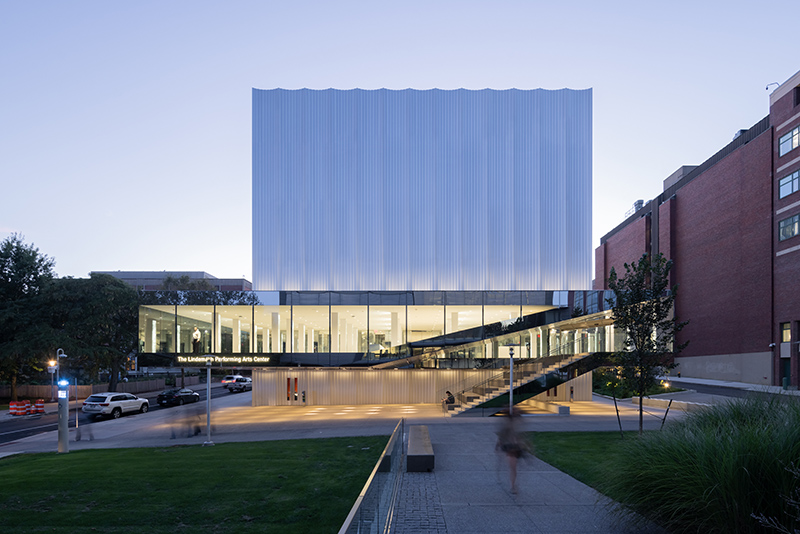
Shawmut Design and Construction completes 101,000 s/f The Lindemann Performing Arts Center at Brown University

Providence, RI Shawmut Design and Construction joined leaders from Brown University on October 21st to celebrate the completion of The Lindemann Performing Arts Center (The Lindemann).
Located centrally in Brown’s Perelman Arts District, the 101,000 s/f building—designed by REX/Joshua Ramus and managed by the Brown Arts Institute (BAI)—offers a radical, one-of-a-kind approach to spatial, acoustic, and technical flexibility. Interweaving innovative design, year-round arts programming, and gathering and rehearsal spaces, The Lindemann aims to increase accessibility to cutting edge artistic resources to further cultivate a community committed to the arts.
“As we proudly unveil our latest project at Brown University with The Lindemann Performing Arts Center, we celebrate the culmination of a remarkable journey—one that underscores the team’s prowess in navigating the complexities of building at this scale,” said Ron Simoneau, executive vice president of education at Shawmut Design and Construction. “This project has successfully woven together architectural brilliance, cutting-edge technology, and adaptability to bring forth a facility that not only meets the diverse needs of Brown’s creative community but sets a new standard for what is possible in performance venues. The Lindemann will serve as a dynamic hub, fostering creativity, collaboration, and artistic exploration for generations to come.”
A collaboratively curated, reconfigurable space, The Lindemann’s Main Performance Hall is unprecedented in its ability to transform. Incorporating a new performance typology, all six surfaces of the hall (floor, ceiling, and four walls) modulate physically and/or acoustically through automated and manually assisted performance equipment to create five radically different stage-audience configurations—experimental media, recital, end-stage, orchestra, and flat floor—and an array of potential secondary modes. The equipment installed to make such transformations includes five suspended, four-tier seating gantries, forty adjustable acoustic reflector panels, seven motorized utility battens, three lighting bridges, two stage lifts, three orchestra platform lifts, six telescoping orchestra risers, three seating wagon lifts, a three-unit retractable seating system, five seating wagons, a ring of deployable acoustic curtains, and a complete technical gridiron 25 ft. above the floor.
“The transformational capabilities of The Lindemann respond to the students’ needs, as well as the University’s pedagogical structure, reflecting its commitment to excellence and adaptability to provide an architectural tool capable of expanding its artistic offerings,” said REX principal architect Joshua Ramus.
The Lindemann’s fluted aluminum façade is intersected by a stage-level “clearstory” that reveals the interior of the main floor in every direction, welcoming passersby to witness and engage with the creation of art in the space and providing views of “Infinite Composition,” a site-specific, light installation by artist Leo Villareal.
One story up from the street, the clearstory cantilevers on three sides of the building, creating sheltered outdoor spaces for events, performances, and gatherings, while inside the building it houses the Nelson Atwater Lobby, a promenade with direct views to the main hall, and an assembly area for performers that can serve as a more intimate lobby.
Below street level, three spaces designed for music, theater, and dance will enable students, faculty, and visiting artists to create cutting-edge, original artwork in flexible, well-equipped studios. Each includes a control room and customizable equipment, allowing the rooms to function as studios, classrooms, and performance spaces where artists and scholars can engage in experiments, fabrications, installations, and speculative projects.
“The opening of The Lindemann marks a moment of catalyzing potential for the future of the University, cementing its commitment to artistic practices on campus and in the broader Providence community,” said BAI Artistic Director Avery Willis Hoffman. “We are excited to welcome students into the space to engage with its leading technology and programming, and with each other, faculty, on-campus arts groups, and leading visiting artists and performing arts organizations that will be made available to them through our collaborative programming.”
Adjacent to other arts-centered academic facilities in the campus core, The Lindemann’s location will establish a hub of creative activity on campus, as it hosts year-round programming, rehearsals, research-focused courses, collaborations, community partnerships, and BAI commissions.